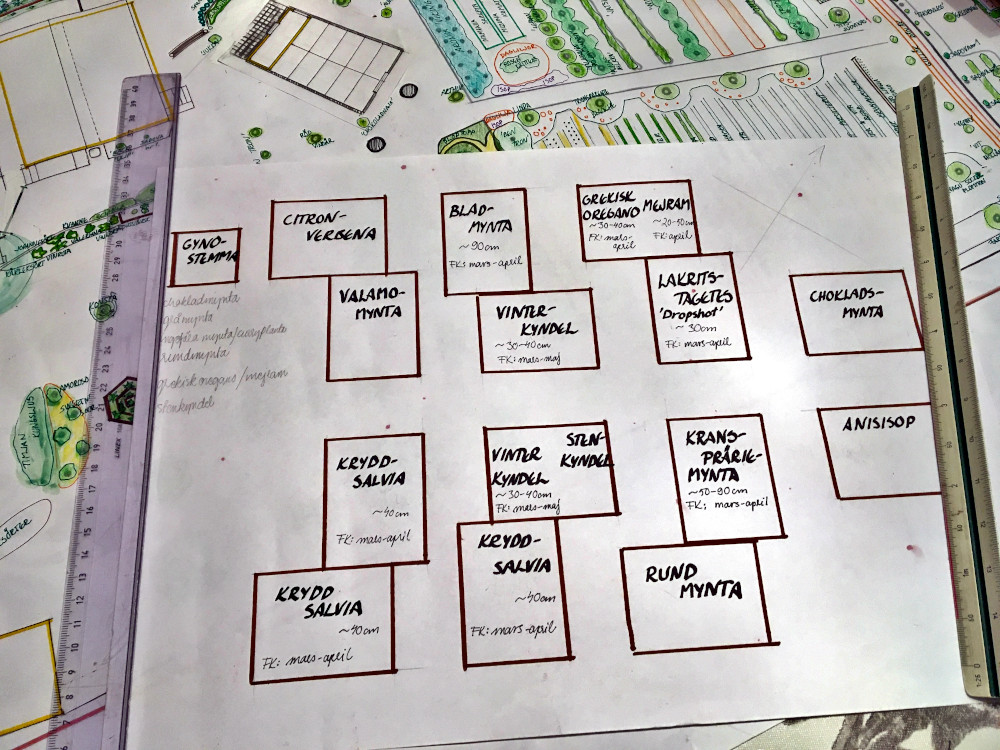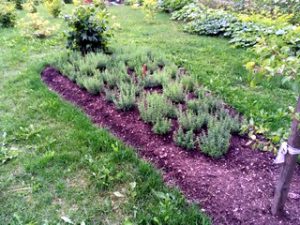Herbs
EXTENDING THE HERB GARDEN
Our herb garden was a geometrical construction of 14 pallet collars to begin with. The vegetable plot wasn’t ready so the herb garden contained a lot of other things like squash and tomatoes. We carried on like this for the next few years, some herbs managed OK, others not.
Last year the focus was on herbs for infusions and Asiatic greens, which we wanted to try. Now having a greenhouse it was possible to grow basil for the first time and that’s why the usual herbs like thyme, oregano, tarragon and salvia got a little less attention. But then again we can say that starting from now we can see where they grow best and see if we can manage to use them and sell them. We don’t have time for everything even if we’d like to.
The cultivation plans for next season look like this.

The main emphasis is now on herbs that we would like to use in herbal infusions. This means herbs like winter savory and salvia, different kinds of mints and American wild basil, liquorice marigold and lemon verbena. Thyme has found its home by the storehouse wall while tarragon is on the edge of the vegetable plot and lovage is growing in a corner with the truffle trees etc., etc. If everything goes as planned then this summer will be the last for the pallet collars and we’ll dig the foundations for the Orangery. Only time will tell.
There are a few herbs I would love to grow but the results so far have not been promising. Rosemary, lavender, lemon thyme, camomile…we’ll keep trying.
”FIMEAS LIST
The so called list of medicinal herbs has always attracted a feeling of awe. The Finnish Medicines Agency maintains and improves the health of the population by monitoring and developing the domain of medicines. Some of the plants or parts of plants that have been registered on the list seem strange (pumpkin seeds) while others go without saying (belladonna). Private citizens are not allowed to to sell plants on the list for medicinal purposes but are allowed to grow them.
That’s why you can find, within Tallbacka Garden, a section with questionable forbidden plants. The following plants were represented in the autumn of 2020: Valerian, Borage, Feverfew, Lily of the Valley, Lungwort, common Soapwort, Rue, Comfrey, Tansy, Ivy, Garden Angelica and Coneflower. The list for sowing contains at least Wormwood, Motherwort, Opium Poppy and Milk Thistle.
We do not grow any plants that are deadly in small doses because our slogan is, after all, “Everything is edible” meaning edible not just once!
Favoritörter och nya försök
It’s annoying, but you just don’t have time for everything. The new cultivation method NO-DIG, to build growing beds and make compost, has taken most of our limited time. Herb cultivation and especially the harvest of them has been put on hold. Anyway, something’s happened.
Satureja montana
We were able to conclude when we tested tea blends in 2020 that the Vikings winter savoury gives a sting in the Rehab Jo Jo mixture. At the same time, it also became clear that we need large quantities of fresh herbs and that the drying and handling of herbs is labour intensive. In the spring of 2021 we set up a growing bed with winter savoury plants and it started to grow nicely. I’m sure they’ll be harvesting next year.

Salvia Salvia officinalis
What we have told you before also concerns sage. It is much more demanding and grows slowly, overwintering is always uncertain. It is difficult to dry sage because the temperature should not be so high that the leaves turn brown. All this is still worth the trouble, it was said already in ancient times that whoever has sage growing on the farm will never die!
Basil Ocimum
We intend to continue growing basil even though the year 2021 was so-and-so. The cause was not herbal, but our own. Tomato and basil also belong together, they want to grow next to each other. The selection of varieties changes slightly. The usual Genovese basil is included but I also want to try the lettuce basil Lettuce Leaf in Tallbacka Mix, camphor basil, holy basil (tulsi) and the spicy Thai basil.
Chervil Antriscus cerefolium
We thought we’d try this aniseed-flavored delicacy in the salad mix. (inspired by Dowding)
Parsley Petroselinum
In the autumn, we sowed three different varieties of parsley: Ruffled parsley Mosscurled, smooth parsley Gigante d’Italia and French parsley. The cold winter and raised bed bodes well.
Evening primrose Oenothera biennis
I have long dreamed of this stately plant and am thinking of growing seedlings incoming spring 2022. In addition to a brilliant (literally) beauty, the evening primrose is also a medicinal plant and it has been used as a vegetable. It attracts butterflies.
Angelica Angelica archangelica
In 2020, we bought a plant as many sowing attempts had failed. It is difficult to get enough fresh seeds. Unfortunately, the plant did not thrive because the place where we planted it was too dry and sunny. But I’m not giving up. We will get enough of this vegetable/herbal/medicine that has been named by the archangel.
Mints Mentha
We have many varieties of mint in the pallet collars, but I have become sceptical about them. The varieties are not always what it says on the sign. I think it is best to taste and see if the plant in question is useful. In any case, our mints need more irrigation and maybe some compost in the spring. All those that taste good will end up in the Myntix tea blend.